Blacklands Program
Arkansas

Partners are working together to restore the blackland prairies and woodlands for improved wildlife habitat and great wildflower blooms.
Ecological Significance
The blacklands of southwestern Arkansas, a landscape dominated by tall native grasses and vibrant wildflowers, had a watery beginning. Millions of years ago Gulf waters covered the region. As the waters receded, they left behind deposits of shellfish that formed a chalky layer underneath a deep mantle of rich, black soil. It’s from this dark soil that the blacklands get their name. The state’s blackland prairies and associated woodlands harbor more than 600 types of plants, including 21 globally imperiled plant communities. Some 315 animal species are found at blackland sites, including rare birds like Bachman’s sparrow, Henslow’s sparrow, painted bunting and Harlan’s hawk.
Threats
Originally about 12 million acres of blackland prairies and woodlands covered parts of Arkansas, Texas, Louisiana, Mississippi and Alabama. Today only some 10,000 acres remain in scattered patches. Most of the original blackland landscape disappeared in the last 150 years, and high quality remnants are increasingly rare. The open terrain and rich soils were appealing for agricultural fields, pastures and tree plantations. Today remaining blackland sites are losing ground to suburban development.

What We've Done
During the 1980s and ’90s, The Nature Conservancy partnered with the Arkansas Natural Heritage Commission in conducting ecological assessments to identify and conserve the least disturbed blackland sites. In 1991 TNC and the Commission acquired Terre Noire Natural Area, a prime blackland site in Clark County that now covers approximately 490 acres. In 1997, the partnership expanded with the Arkansas Game and Fish Commission’s acquisition of the Rick Evans Grandview Prairie Wildlife Management Area. At 4,885 acres, it is the largest blacklands conservation site in the United States.
Between 1998 and 2001, TNC acquired 120 acres of blackland habitat in Hempstead County to create Columbus Prairie Preserve, where one of Arkansas’ rarest plants – the eared false foxglove – now flourishes after fire was restored at the site. In 2004, TNC transferred 66 acres in Howard County to the Arkansas Natural Heritage Commission to create Saratoga Blackland Prairie Natural Area. And in 2008 TNC and the Natural Heritage and Game and Fish commissions entered a partnership to conserve the 1,018-acre Oak Ridge Ravines Preserve in Hempstead County.
Ongoing Conservation Actions
TNC and its partners are continually working to restore blackland sites in Arkansas. With the absence of fire for decades, encroaching woody plants like Eastern red cedars have grown to a point that they’re now resistant to low-intensity prescribed fires that closely mimic natural fires. At several blackland sites, cedars by the thousands are being cut so that prescribed fire can be applied to restore prairie openings.
TNC, with help from volunteers and partners, repairs erosion damage, collects native prairie seeds and disperses them in degraded areas, and removes invasive plants. Staff ecologists then follow up with monitoring to assess the effects of stewardship activities on target plant species and communities. Their data have confirmed what the eye can easily see – cedar thickets have turned back into prairies teeming with vibrant wildflowers and lush grasses that support a plethora of animals.
Through the Landowner Incentive Program, TNC and its partners are working with neighboring landowners who want to conserve their own blacklands and improve wildlife habitat on their property. Contact us today to learn more!
Sign up for Nature News.
Sign up to receive monthly conservation news and updates from Arkansas.


